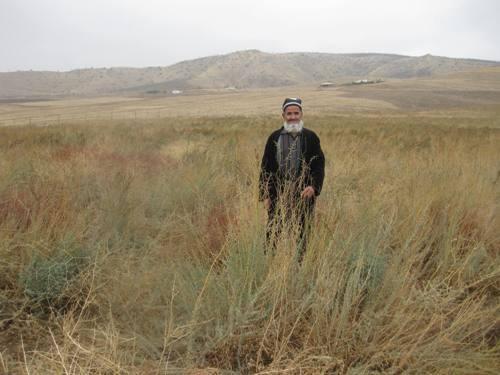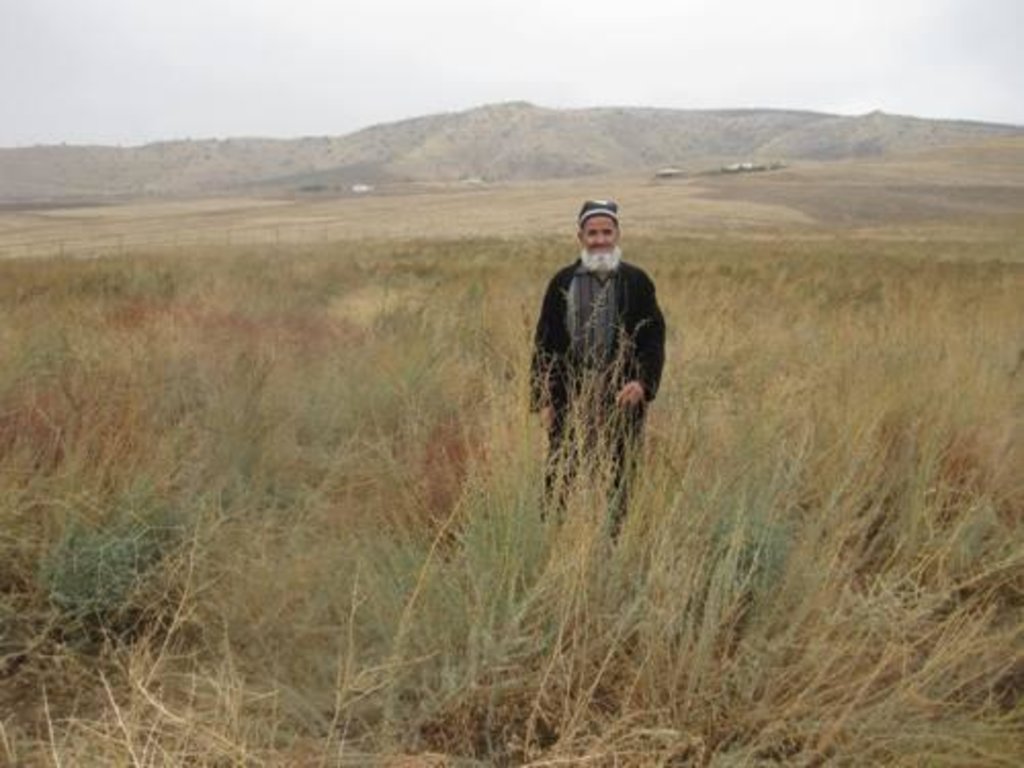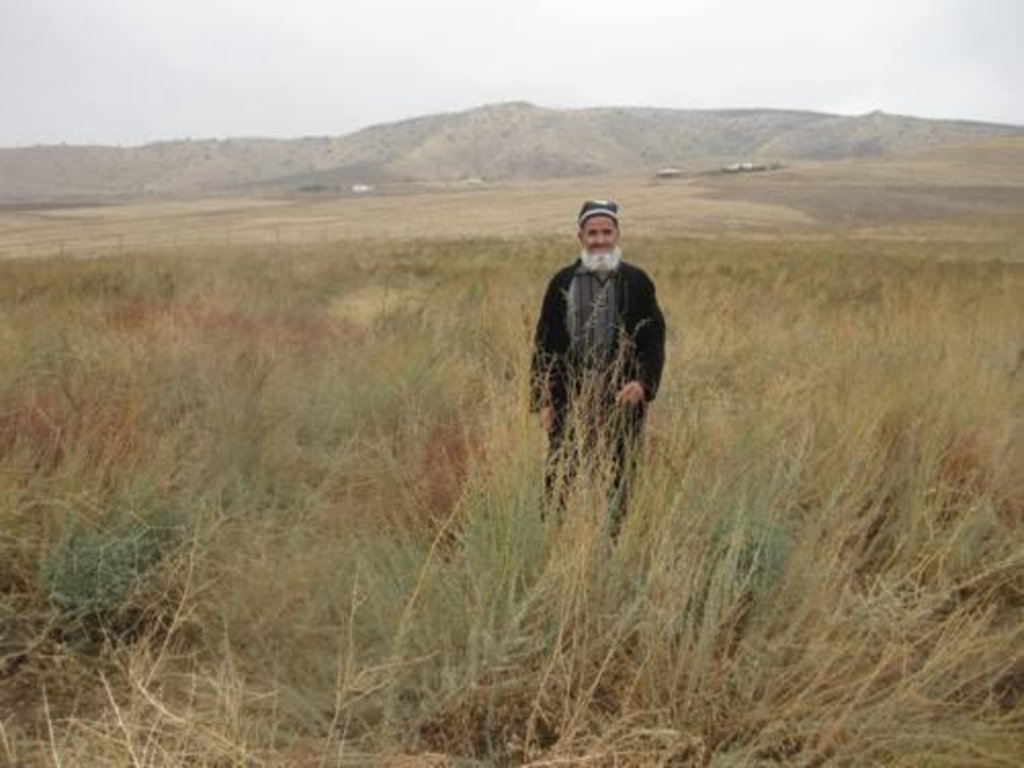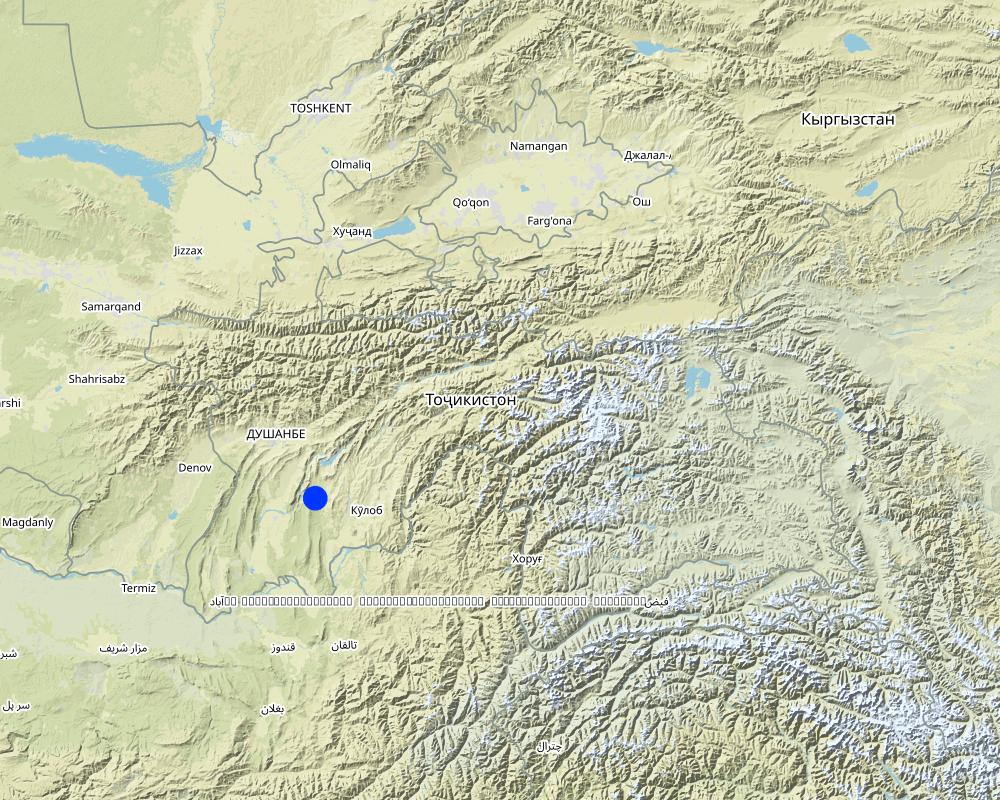Rehabilitation of grazing areas through planting of Izen perennial shrubs [Tajikistan]
- Creation:
- Update:
- Compiler: Tuychiboy Safarov
- Editor: –
- Reviewers: Alexandra Gavilano, Fabian Ottiger, Joana Eichenberger
technologies_1053 - Tajikistan
- Full summary as PDF
- Full summary as PDF for print
- Full summary in the browser
- Full summary (unformatted)
- Rehabilitation of grazing areas through planting of Izen perennial shrubs: Nov. 2, 2021 (public)
- Rehabilitation of grazing areas through planting of Izen perennial shrubs: Aug. 7, 2017 (inactive)
- Rehabilitation of grazing areas through planting of Izen perennial shrubs: Aug. 15, 2019 (inactive)
- Rehabilitation of grazing areas through planting of Izen perennial shrubs: June 3, 2017 (inactive)
- Rehabilitation of grazing areas through planting of Izen perennial shrubs: Dec. 27, 2016 (inactive)
View sections
Expand all Collapse all1. General information
1.2 Contact details of resource persons and institutions involved in the assessment and documentation of the Technology
Key resource person(s)
SLM specialist:
Mustafoev Abdurasul
World Bank
United States
1.3 Conditions regarding the use of data documented through WOCAT
The compiler and key resource person(s) accept the conditions regarding the use of data documented through WOCAT:
Yes
2. Description of the SLM Technology
2.1 Short description of the Technology
Definition of the Technology:
Development of grazing areas through plantation of Izen
2.2 Detailed description of the Technology
Description:
Improvement of grazing areas through plantation of izen in non-used areas for improvement of condition of grazing areas and to increase fodder basis.
In general, grazing territories located in Tohirsu watershed are severely degraded due to overgrazing and digression. Pastures that are located on mountain slopes have turned into paths, bare ground and tussocks. Soil is often washed out, it is quite stony; Pastures are located on steep slopes, pastures that located close to settlements are severely degraded and covered by noxious plants and burrs. Grazing areas suffer from non-regulated daily and annual grazing during spring-summer-autumn period or even all-year-round. Vegetation cover was severely damaged by overgrazing, couch grass can be seen in some places, soil suffer from water erosion, multiple gullies have formed and etc.
Non-regulated grazing causes damage to grass cover and changes ecological situation in the area. Continuous grazing compacts or destroys soil cover and causes specific forms of the so-called “grazing microtopography”. As a result, soil permeability is reduced, runoff level increases, pit-run fines, humus and mineral nutrients are washed out. This severely affects soil fertility. As a result, grass cover is reduced as well as the total number of animals that can be grazed there. Thus, additional measures for ecological optimization of grazing areas are needed.
With support of the project and local initiative group 5ha of non-used areas were selected in Lokhur Jamoat of Dangara region for plantation of izen (Kochia). The overall idea was to improve the condition of grazing areas, prevent wind and water erosion through plantation of izen. With 100% germination capacity 6-8kg of seeds are needed per one hectare. Seeds are selected with the use of laboratory analysis. Simultaneous tillage and harrowing at depth of 25-30cm allowed to save fuel and funds. Seeds of izen of “Kuikanak” sort were planted at the depth of 0,5-1,0cm. The area sown with izen was fenced. “Kuikanak” is tolerant to +40C temperature and is really good for climatic conditions of Dangara region. Its root system reaches 80-150cm per year.
Purpose of the Technology: The overall goal of the idea was to improve the condition of grazing areas, prevent wind and water erosion, rehabilitate saline soils, preserve moisture in soils, increase fodder basis, enrich soil organic matter with nitrates, harvest and sale seeds and improve rural livelihoods. Improve agricultural conditions, increase and create soils that can resist degradation. Create favorable socio-economic and ecologic conditions for rural population.
Establishment / maintenance activities and inputs: First of all, a group of common interest has been set up. Group members took part in a workshop on application of this technology. During the workshop it was suggested to improve productive capacity of grazing areas. Members of the group have selected a 5ha grazing area in Lokhur Jamoat. According to the project, the group has provided 20% of funding. At the initial stage land was prepared for tillage. Izen seeds were planted following the laboratory analysis. Average lifetime of izen is 25-30 years.
Natural / human environment: Izen is mainly used to enrich arid grazing areas. Biological value of izen is that it is tolerant to hot summer periods that are typical for south Tajikistan. At the same time, izen also grows in the eastern Pamir where winter temperatures vary from -40 down to -45C.
The selected land is the property of the group of common interest which has official land use certificate. The group consists of representatives of 10 households. They have equal access to fodder crops, seeds and have equal grazing opportunities.
2.3 Photos of the Technology
2.5 Country/ region/ locations where the Technology has been applied and which are covered by this assessment
Country:
Tajikistan
Region/ State/ Province:
Tajikistan
Further specification of location:
Dangara, Lokhur
Comments:
Boundary points of the Technology area: only approximate coordinates
Total area covered by the SLM Technology is 0.05 km2.
Map
×2.6 Date of implementation
If precise year is not known, indicate approximate date:
- 10-50 years ago
2.7 Introduction of the Technology
Specify how the Technology was introduced:
- during experiments/ research
Comments (type of project, etc.):
With proper grazing and pasture management the technology can be used for a period of 25 years
3. Classification of the SLM Technology
3.2 Current land use type(s) where the Technology is applied

Grazing land
Comments:
Major land use problems (compiler’s opinion): Prevention from wind and water erosion, improvement of fodder basis
Major land use problems (land users’ perception): A Group of Common Interest has been set up
Future (final) land use (after implementation of SLM Technology): Cropland: Cp: Perennial (non-woody) cropping
3.3 Has land use changed due to the implementation of the Technology?
Has land use changed due to the implementation of the Technology?
- Yes (Please fill out the questions below with regard to the land use before implementation of the Technology)

Cropland

Grazing land
Comments:
Future (final) land use (after implementation of SLM Technology): Cropland: Cp: Perennial (non-woody) cropping
Grazing land: Gi: Intensive grazing/ fodder production
3.4 Water supply
Water supply for the land on which the Technology is applied:
- rainfed
Comments:
Longest growing period in days: 6Longest growing period from month to month: 8
3.6 SLM measures comprising the Technology

agronomic measures
- A1: Vegetation/ soil cover
- A3: Soil surface treatment
- A5: Seed management, improved varieties
A3: Differentiate tillage systems:
A 3.2: Reduced tillage (> 30% soil cover)

vegetative measures
- V2: Grasses and perennial herbaceous plants

structural measures
- S1: Terraces

management measures
- M5: Control/ change of species composition
Comments:
Main measures: vegetative measures, management measures
Type of agronomic measures: better crop cover, early planting, minimum tillage
Type of vegetative measures: scattered / dispersed
3.7 Main types of land degradation addressed by the Technology

soil erosion by water
- Wt: loss of topsoil/ surface erosion
Comments:
Main causes of degradation: soil management, population pressure
Secondary causes of degradation: crop management (annual, perennial, tree/shrub), overgrazing, land tenure, poverty / wealth
3.8 Prevention, reduction, or restoration of land degradation
Specify the goal of the Technology with regard to land degradation:
- prevent land degradation
- reduce land degradation
Comments:
Основная цель: предотвращение деградации земель
Второстепенные цели: реабилитация / восстановление голых земель, снижение деградации земель
4. Technical specifications, implementation activities, inputs, and costs
4.1 Technical drawing of the Technology
Technical specifications (related to technical drawing):
This saline soil was sown with izen in February. This is izen 10 months after initial planting during vegetative period.
Location: Dangara, Jamoat Lokhur. Khatlon
Technical knowledge required for field staff / advisors: moderate
Technical knowledge required for land users: moderate
Technical knowledge required for moderate
Main technical functions: control of dispersed runoff: retain / trap
Secondary technical functions: improvement of ground cover, stabilisation of soil (eg by tree roots against land slides)
Better crop cover
Material/ species: dig and plant izen
Quantity/ density: 8kg per ha
Remarks: aligning and fencing
Early planting
Material/ species: second half of Febryary
Remarks: seeds after lab analysis
Minimum tillage
Material/ species: tillage and hoening
Remarks: leveling
Scattered / dispersed
Vegetative material: T : trees / shrubs
Number of plants per (ha): 8kg of seeds
Trees/ shrubs species: Izen seeds
Author:
Safarov T.S., Dushanbe
4.3 Establishment activities
| Activity | Timing (season) | |
|---|---|---|
| 1. | Tillage | February |
| 2. | Fencing | |
| 3. | Leveling | |
| 4. | Planting |
4.4 Costs and inputs needed for establishment
| Specify input | Unit | Quantity | Costs per Unit | Total costs per input | % of costs borne by land users | |
|---|---|---|---|---|---|---|
| Labour | medium | hectare | 1.0 | 69.0 | 69.0 | 100.0 |
| Equipment | machine use | hectare | 1.0 | 45.0 | 45.0 | 20.0 |
| Equipment | tools | pc | 1.0 | 20.0 | 20.0 | 20.0 |
| Plant material | seeds | pc | 1.0 | 80.0 | 80.0 | 20.0 |
| Construction material | wire fencing | meter | 1.0 | 285.6 | 285.6 | 20.0 |
| Total costs for establishment of the Technology | 499.6 | |||||
| Total costs for establishment of the Technology in USD | 499.6 | |||||
4.5 Maintenance/ recurrent activities
| Activity | Timing/ frequency | |
|---|---|---|
| 1. | Hay production | |
| 2. | Harvesting |
4.6 Costs and inputs needed for maintenance/ recurrent activities (per year)
| Specify input | Unit | Quantity | Costs per Unit | Total costs per input | % of costs borne by land users | |
|---|---|---|---|---|---|---|
| Labour | medium | hectare | 1.0 | 50.4 | 50.4 | 100.0 |
| Total costs for maintenance of the Technology | 50.4 | |||||
| Total costs for maintenance of the Technology in USD | 50.4 | |||||
5. Natural and human environment
5.1 Climate
Annual rainfall
- < 250 mm
- 251-500 mm
- 501-750 mm
- 751-1,000 mm
- 1,001-1,500 mm
- 1,501-2,000 mm
- 2,001-3,000 mm
- 3,001-4,000 mm
- > 4,000 mm
5.2 Topography
Slopes on average:
- flat (0-2%)
- gentle (3-5%)
- moderate (6-10%)
- rolling (11-15%)
- hilly (16-30%)
- steep (31-60%)
- very steep (>60%)
Landforms:
- plateau/plains
- ridges
- mountain slopes
- hill slopes
- footslopes
- valley floors
Altitudinal zone:
- 0-100 m a.s.l.
- 101-500 m a.s.l.
- 501-1,000 m a.s.l.
- 1,001-1,500 m a.s.l.
- 1,501-2,000 m a.s.l.
- 2,001-2,500 m a.s.l.
- 2,501-3,000 m a.s.l.
- 3,001-4,000 m a.s.l.
- > 4,000 m a.s.l.
5.3 Soils
Soil depth on average:
- very shallow (0-20 cm)
- shallow (21-50 cm)
- moderately deep (51-80 cm)
- deep (81-120 cm)
- very deep (> 120 cm)
Soil texture (topsoil):
- coarse/ light (sandy)
Topsoil organic matter:
- low (<1%)
5.4 Water availability and quality
Ground water table:
> 50 m
Availability of surface water:
poor/ none
Water quality (untreated):
unusable
5.5 Biodiversity
Species diversity:
- low
5.6 Characteristics of land users applying the Technology
Market orientation of production system:
- subsistence (self-supply)
Off-farm income:
- 10-50% of all income
Relative level of wealth:
- poor
Individuals or groups:
- groups/ community
Level of mechanization:
- manual work
- mechanized/ motorized
Gender:
- women
- men
Indicate other relevant characteristics of the land users:
Land users applying the Technology are mainly disadvantaged land users
Difference in the involvement of women and men: Major portion of the population is unemployed
Population density: 10-50 persons/km2
Off-farm income specification: Firs yield is used for internal purposes, then seeds are produced and animals are grazed
5.7 Average area of land used by land users applying the Technology
- < 0.5 ha
- 0.5-1 ha
- 1-2 ha
- 2-5 ha
- 5-15 ha
- 15-50 ha
- 50-100 ha
- 100-500 ha
- 500-1,000 ha
- 1,000-10,000 ha
- > 10,000 ha
Is this considered small-, medium- or large-scale (referring to local context)?
- small-scale
5.8 Land ownership, land use rights, and water use rights
Land ownership:
- communal/ village
5.9 Access to services and infrastructure
health:
- poor
- moderate
- good
education:
- poor
- moderate
- good
technical assistance:
- poor
- moderate
- good
employment (e.g. off-farm):
- poor
- moderate
- good
markets:
- poor
- moderate
- good
energy:
- poor
- moderate
- good
roads and transport:
- poor
- moderate
- good
drinking water and sanitation:
- poor
- moderate
- good
financial services:
- poor
- moderate
- good
6. Impacts and concluding statements
6.1 On-site impacts the Technology has shown
Socio-economic impacts
Production
crop production
fodder production
Income and costs
farm income
Socio-cultural impacts
food security/ self-sufficiency
community institutions
SLM/ land degradation knowledge
situation of socially and economically disadvantaged groups
Ecological impacts
Water cycle/ runoff
surface runoff
Soil
soil moisture
soil cover
soil loss
soil compaction
Climate and disaster risk reduction
wind velocity
6.2 Off-site impacts the Technology has shown
wind transported sediments
damage on neighbours' fields
6.3 Exposure and sensitivity of the Technology to gradual climate change and climate-related extremes/ disasters (as perceived by land users)
Gradual climate change
Gradual climate change
| Season | increase or decrease | How does the Technology cope with it? | |
|---|---|---|---|
| annual temperature | increase | well |
Climate-related extremes (disasters)
Meteorological disasters
| How does the Technology cope with it? | |
|---|---|
| local rainstorm | well |
Climatological disasters
| How does the Technology cope with it? | |
|---|---|
| drought | well |
6.4 Cost-benefit analysis
How do the benefits compare with the establishment costs (from land users’ perspective)?
Short-term returns:
slightly positive
Long-term returns:
positive
How do the benefits compare with the maintenance/ recurrent costs (from land users' perspective)?
Short-term returns:
slightly positive
Long-term returns:
very positive
Comments:
Single tillage and izen seeds are planted after fencing of the area. One year after initial planting fence will be removed. The technology can be used for a period of 25 years.
6.5 Adoption of the Technology
Comments:
100% of land user families have adopted the Technology with external material support
10 land user families have adopted the Technology with external material support
Comments on acceptance with external material support: The technology was implemented with support from the World Bank and the group of common interest
Comments on adoption trend: After the project people got interested in growing izen
6.7 Strengths/ advantages/ opportunities of the Technology
| Strengths/ advantages/ opportunities in the land user’s view |
|---|
| Can be applied in saline soils |
| Can be used as additional source of income for farmers and rural population, fodder production and sale of seeds |
| Expansion of grazing areas |
| Prevents soil from erosion |
| Strengths/ advantages/ opportunities in the compiler’s or other key resource person’s view |
|---|
|
The technology can be used in areas that are not used for cultivation of other crops How can they be sustained / enhanced? Effective for a period of 25 years |
|
Can be applied in saline soils in different climatic conditions. Tolerant to draughts How can they be sustained / enhanced? One year after initial planting fence can be removed |
|
Increases fodder basis. Reduces load on grazing areas. How can they be sustained / enhanced? Transportation of seeds to other areas by wind |
| Income from sale of seeds. Demand for seeds. |
| Prevents soil from wind and water erosion |
6.8 Weaknesses/ disadvantages/ risks of the Technology and ways of overcoming them
| Weaknesses/ disadvantages/ risks in the compiler’s or other key resource person’s view | How can they be overcome? |
|---|---|
| During the first year should be protected from animals | Area should be fenced |
| Fencing requires funds | Can be done through support of donors and projects |
| Limited during the first year |
Links and modules
Expand all Collapse allLinks
No links
Modules
No modules





